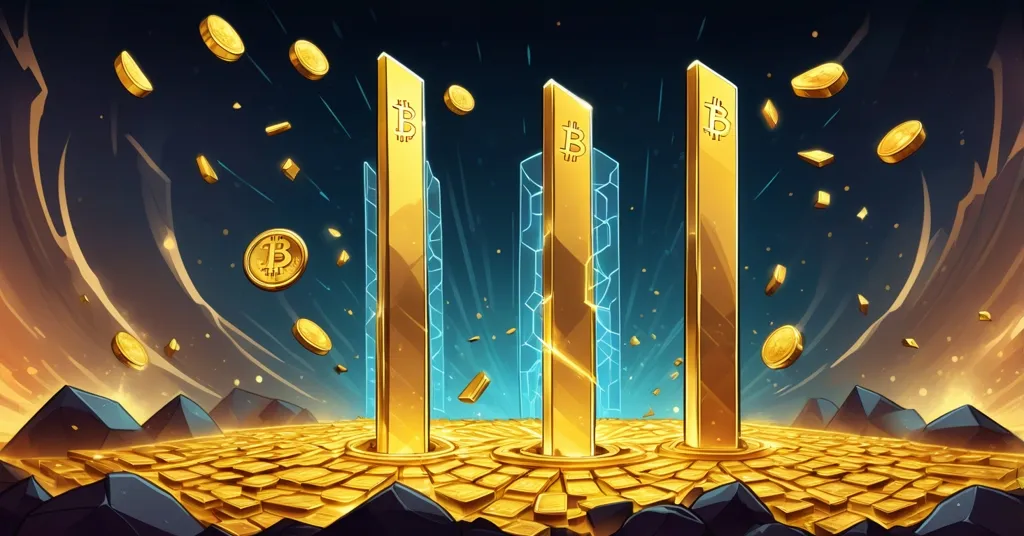Peter Schiff Pushes Gold Tokenization: A Bitcoin Rival or Blockchain Win?

Peter Schiff’s Gold Tokenization Push: A Bitcoin Rival or Blockchain Breakthrough?
Peter Schiff, the infamous gold advocate and relentless Bitcoin skeptic, has a new bone to pick with the crypto king. He’s championing gold tokenization as the true killer app for blockchain tech, claiming it fuses the timeless value of gold with digital efficiency, leaving Bitcoin—a “digital fool’s gold” in his eyes—in the dust. Is this a game-changer for real-world assets on the blockchain, or just another distraction from Bitcoin’s disruptive march?
- Schiff’s Argument: Tokenized gold merges blockchain’s speed with gold’s proven worth, trumping Bitcoin’s speculative nature.
- Market Reality: Tokenized gold is valued at $1.7 billion as of mid-2025, a speck next to Bitcoin’s trillion-dollar dominance.
- Core Tension: Does blockchain’s future lie in tangible assets or pure digital freedom?
What Is Gold Tokenization, and Why Does Schiff Care?
For those new to the concept, gold tokenization is the process of representing physical gold as digital tokens on a blockchain. Imagine it as a digital IOU for a specific amount of gold—say, a gram or an ounce—securely stored in audited vaults. Platforms like Paxos Gold (PAXG) and Tether Gold (XAUT) issue these tokens, which you can buy, sell, or trade 24/7 on decentralized exchanges, or even redeem for the actual shiny stuff. It’s gold with a digital edge, slashing through the old-school barriers of divisibility, portability, and sluggish transactions. If you’re curious about the mechanics, gold tokenization explained offers a deeper dive into its history and setup.
Peter Schiff, a die-hard economist rooted in the Austrian school of thought, has long worshipped gold for its 5,000-year track record as a store of wealth, especially during crises like the 2008 financial meltdown. He sees blockchain as a tool to modernize his precious metal, not to birth speculative fantasies like Bitcoin. His argument is blunt: tokenized gold enhances gold’s monetary traits—making it divisible down to tiny fractions, portable via a simple wallet address, and fast to transact—without sacrificing its intrinsic value as a tangible asset. For more on his stance, check out this discussion on why Schiff prefers tokenized gold over Bitcoin.
“Blockchain’s real utility lies in tokenizing tangible assets like gold, not creating worthless strings of numbers,” Schiff has declared.
He doubles down, arguing that tokenized gold “improves on all the monetary characteristics” gold already offers. Unlike hauling heavy bars or paying steep storage fees, digital tokens let you move value across borders instantly. With the tokenized gold market sitting at $1.7 billion as of mid-2025—a mere drop compared to the global gold market’s staggering $22 trillion—Schiff sees untapped potential. Tokenizing just 1% of that market could inject billions into the blockchain space, a prospect even institutional players are sniffing out, with moves like BioSig Technologies’ $1.1 billion financing for a gold-backed treasury strategy. For detailed insights, see this analysis on tokenized gold market growth and institutional adoption.
Tokenized Gold’s Edge: Accessibility and Emerging Markets
One of tokenized gold’s strongest selling points is accessibility. Physical gold often demands hefty upfront costs, storage solutions, and logistical headaches. Tokenization obliterates those barriers, letting you own a fraction of a gram for a fraction of the cost. This is a big deal in emerging markets like India and China, where gold isn’t just an investment but a cultural obsession, often tied to weddings and generational wealth. Yet, import duties exceeding 20% and supply chain snarls make physical ownership a pain. Tokenized gold sidesteps these issues, allowing anyone with a smartphone to stack digital gold without the red tape or risk of smuggling bars through customs. Its impact in emerging markets is particularly noteworthy for financial inclusion.
This democratizing force aligns with blockchain’s ethos of financial inclusion, a point even Bitcoin diehards can’t easily dismiss. Beyond ownership, tokenized gold offers liquidity—trade it anytime, anywhere, unlike physical bullion locked in a safe or delayed by dealer hours. Schiff argues this makes gold a contender in the digital age, preserving its status as a safe haven while adapting to modern needs. If his own company, SchiffGold, enters the tokenization race as whispers suggest, it could signal a traditionalist wave into this niche.
Bitcoin’s Counterpunch: Digital Freedom Over Tangible Baggage
Schiff may have his golden gospel, but Bitcoin maximalists aren’t buying it. To him, Bitcoin is a speculative mirage, a bubble of “worthless strings of numbers” destined to burst. But for advocates like Robert Breedlove, Bitcoin’s digital-native design is its greatest strength. No vaults to trust, no storage fees to pay, no redemption delays to sweat over—just pure, borderless value transfer governed by code and consensus. Bitcoin’s divisibility, down to a satoshi (that’s 0.00000001 BTC, a unit so small it enables microtransactions), and scaling solutions like the Lightning Network—a layer that processes payments off-chain for speed and low cost—make it a lean transaction beast. For a broader take on this debate, explore Peter Schiff’s case for gold tokenization over Bitcoin.
Bitcoin’s transparency is another jab at tokenized gold. Every transaction is verifiable on its blockchain; you don’t need to trust a vault auditor or hope an issuer doesn’t go rogue. Grassroots voices online, especially in crypto communities, frame Bitcoin as a hedge against inflation and centralized corruption—a middle finger to the fiat systems Schiff indirectly defends by clinging to gold. With a trillion-dollar market cap, Bitcoin’s staying power isn’t just hype; it’s a cultural and financial force that’s weathered over a decade of doubt. Community perspectives on this clash can be found in this Reddit thread on Schiff’s gold vs. Bitcoin arguments.
Contrast this with tokenized gold’s reliance on physical backing, and Bitcoin proponents see a relic of the old world. Even with blockchain’s polish, gold tokens carry counterparty risks—trust in custodians and vaults—and physical constraints Bitcoin simply doesn’t have. For many, this is the crux: why tether value to a metal when digital scarcity, enforced by math, offers a new paradigm of financial sovereignty?
Challenges of Tokenized Gold: Custodial Risks and Regulatory Minefields
Before we crown tokenized gold as blockchain’s next big thing, let’s face the ugly truths. Custodial risks are a glaring flaw. Those shiny tokens are only as good as the vaults and issuers backing them. It’s like trusting a bank with your cash—if the bank gets robbed or mismanages funds, you’re screwed. If a platform like PAXG or XAUT gets hacked, or a vault operator pulls a fast one, your digital gold turns to dust. This isn’t theoretical; the crypto space has seen plenty of custodial disasters, from exchange hacks to outright scams. For a deeper look at these concerns, check out this Reddit discussion on custodial risks of tokenized gold vs. Bitcoin.
Then there’s the regulatory quagmire. Governments worldwide aren’t exactly throwing confetti at asset-backed tokens. Fears of money laundering and tax evasion put tokenized gold under a harsh spotlight. Agencies like the SEC in the U.S. and global bodies like the Financial Action Task Force (FATF) have already cracked down on similar projects, often demanding strict KYC (Know Your Customer) compliance that could strip away blockchain’s anonymity appeal. Redemption fees and delays for physical gold add more friction—turning tokens back into bars isn’t always a snap, especially if logistics or legal hurdles intervene.
Technical challenges pile on the pain. Many tokenized gold platforms run on Ethereum, where transaction costs—known as gas fees—can spike during network congestion, making small trades uneconomical. Compare that to Bitcoin’s Lightning Network, where microtransactions can cost pennies, and you see a scalability gap. For all Schiff’s enthusiasm, tokenized gold’s adoption remains niche, a $1.7 billion footnote in a crypto market dominated by Bitcoin’s trillion-dollar swagger. These hurdles aren’t dealbreakers, but they’re a far cry from the seamless future Schiff envisions.
DeFi: The Game-Changer for Tokenized Gold?
Here’s where tokenized gold might sneak a win, even over Bitcoin in certain niches: Decentralized Finance, or DeFi. For the uninitiated, DeFi refers to financial applications built on blockchain that let users lend, borrow, or earn interest without traditional banks. Tokenized gold can plug directly into this ecosystem. Picture a small business owner in India using their gold tokens as collateral on a platform like MakerDAO to borrow DAI, a stablecoin pegged to the dollar, for inventory without selling their stack. That’s a lifeline physical bullion can’t offer and a utility Bitcoin, with its price volatility, often struggles to match. To understand more about its potential, see this overview of the benefits and risks of gold tokenization on blockchain.
Gold tokens could also earn yields in DeFi protocols, turning a static asset into a working one. This bridges the dusty world of bullion to the bleeding-edge crypto economy, potentially luring traditional investors who crave stability over Bitcoin’s wild swings. In gold-obsessed markets, this could be the gateway to broader blockchain adoption—a sneaky way to onboard the old guard into decentralized systems. Ethereum’s role here is notable, as its smart contract capabilities enable these complex DeFi interactions, though gas fees remain a thorn in the side.
But let’s not overstate this. DeFi is still a Wild West, riddled with smart contract bugs and regulatory uncertainty. Using tokenized gold in such systems amplifies custodial risks—if the underlying platform fails, your collateral could vanish. Bitcoin, while less DeFi-friendly due to its simpler design, avoids these tangles by sticking to its peer-to-peer roots. Still, for those betting on blockchain’s future in traditional finance, tokenized gold’s DeFi potential is a compelling hook.
A Broader View: Complement or Compete?
The Bitcoin vs. tokenized gold debate often feels like a cage match, but there’s room for a third take. Some blockchain analysts and altcoin advocates—particularly from the Ethereum camp—argue these assets aren’t mutually exclusive. Tokenized gold could complement Bitcoin in a diversified crypto portfolio, offering stability for risk-averse investors while Bitcoin drives the charge against centralized control. Stablecoins like USDT or USDC, also built on Ethereum, show how asset-backed value can coexist with Bitcoin’s digital rebellion, each filling unique niches. For expert takes on this ongoing rivalry, watch this 2023-2025 analysis of Schiff’s gold tokenization vs. Bitcoin debate.
Real-world asset (RWA) tokenization, of which gold is just one slice, is gaining steam beyond Schiff’s narrow lens. Art, real estate, and even government bonds are being digitized, hinting at a future where blockchain redefines ownership across industries. Tokenized gold’s $1.7 billion market is dwarfed by other RWAs in trial phases, but its cultural resonance—especially in Asia—gives it a unique edge. Could this be a stepping stone to broader adoption of blockchain tech, rather than a direct rival to Bitcoin? It’s a perspective worth chewing on.
Our Take: Decentralization Still Reigns
As champions of decentralization at Let’s Talk, Bitcoin, we see Schiff’s push for tokenized gold as a fascinating experiment with real potential to onboard traditionalists to blockchain. Accessibility in emerging markets and DeFi integration are powerful draws, especially for those spooked by Bitcoin’s volatility. But let’s not kid ourselves—Bitcoin’s unapologetic disruption of centralized power remains the beating heart of this financial revolution. Tokenized gold, for all its polish, tethers us to physical constraints and trust issues Bitcoin shed years ago. While tokenizing 1% of the $22 trillion gold market could shift the landscape, dismissing Bitcoin’s role in rewriting the rules of money is a gamble even a gold bug like Schiff might live to regret.
The clash between Schiff’s vision and Bitcoin’s reality isn’t just academic—it’s a window into how we define value in a digital age. Tokenized gold remixes history’s safest bet; Bitcoin flips the bird at the status quo. Both have flaws, both have promise. For now, gold tokenization is a blip against Bitcoin’s war chest, but with institutional moves like BioSig’s and DeFi innovation on the rise, it’s a space to watch. Will it carve a permanent niche, or is it just a shiny detour on the highway to financial sovereignty? That’s the billion-dollar question.
Key Questions and Takeaways on Bitcoin vs. Tokenized Gold
- What exactly is gold tokenization, and how does it work?
It’s the process of digitizing physical gold into blockchain tokens, each tied to a specific amount stored in vaults. Platforms like Paxos Gold (PAXG) and Tether Gold (XAUT) let users trade or redeem these tokens, blending gold’s value with digital speed and accessibility. - Why does Peter Schiff believe tokenized gold beats Bitcoin?
Schiff views Bitcoin as a speculative “digital fool’s gold” with no intrinsic value, while tokenized gold pairs blockchain efficiency with gold’s 5,000-year history as a store of wealth, fixing issues like divisibility and portability. - What unique benefits does tokenized gold offer in emerging markets?
In countries like India and China, it bypasses steep import duties over 20% and logistical barriers, enabling fractional ownership of gold—a culturally vital asset—via digital tokens accessible to anyone with internet. - What are the biggest hurdles for tokenized gold compared to Bitcoin?
Custodial risks (trust in vaults and issuers), regulatory scrutiny from bodies like the SEC, high blockchain fees on Ethereum, and limited adoption ($1.7 billion vs. Bitcoin’s trillions) keep it niche, while Bitcoin’s digital nature avoids many of these traps. - How does DeFi enhance tokenized gold’s potential over Bitcoin?
Tokenized gold can be used as collateral for loans or yield generation in DeFi protocols like MakerDAO, adding financial utility physical gold lacks and Bitcoin struggles to offer due to price swings. - Can tokenized gold and Bitcoin coexist in the blockchain space?
Potentially—analysts suggest tokenized gold could provide stability for risk-averse investors, complementing Bitcoin’s disruptive digital freedom in a diversified crypto portfolio, alongside other real-world asset tokenizations.



